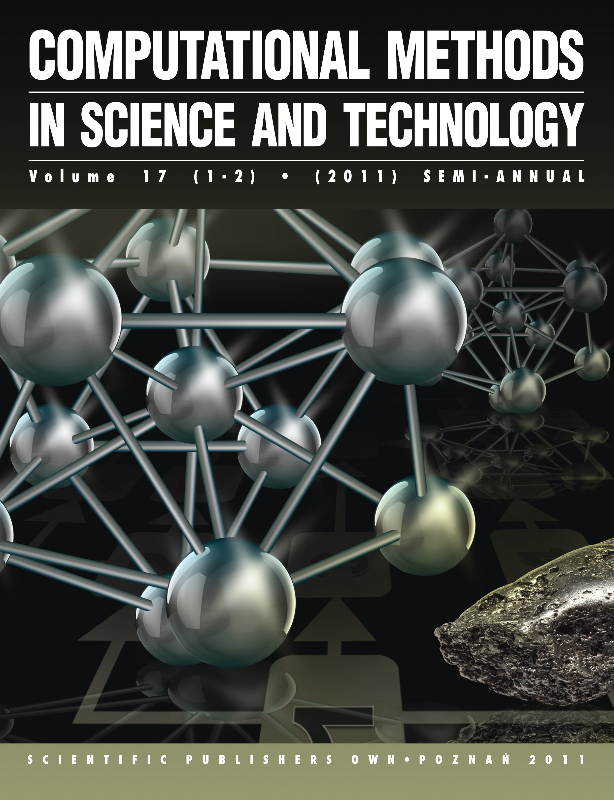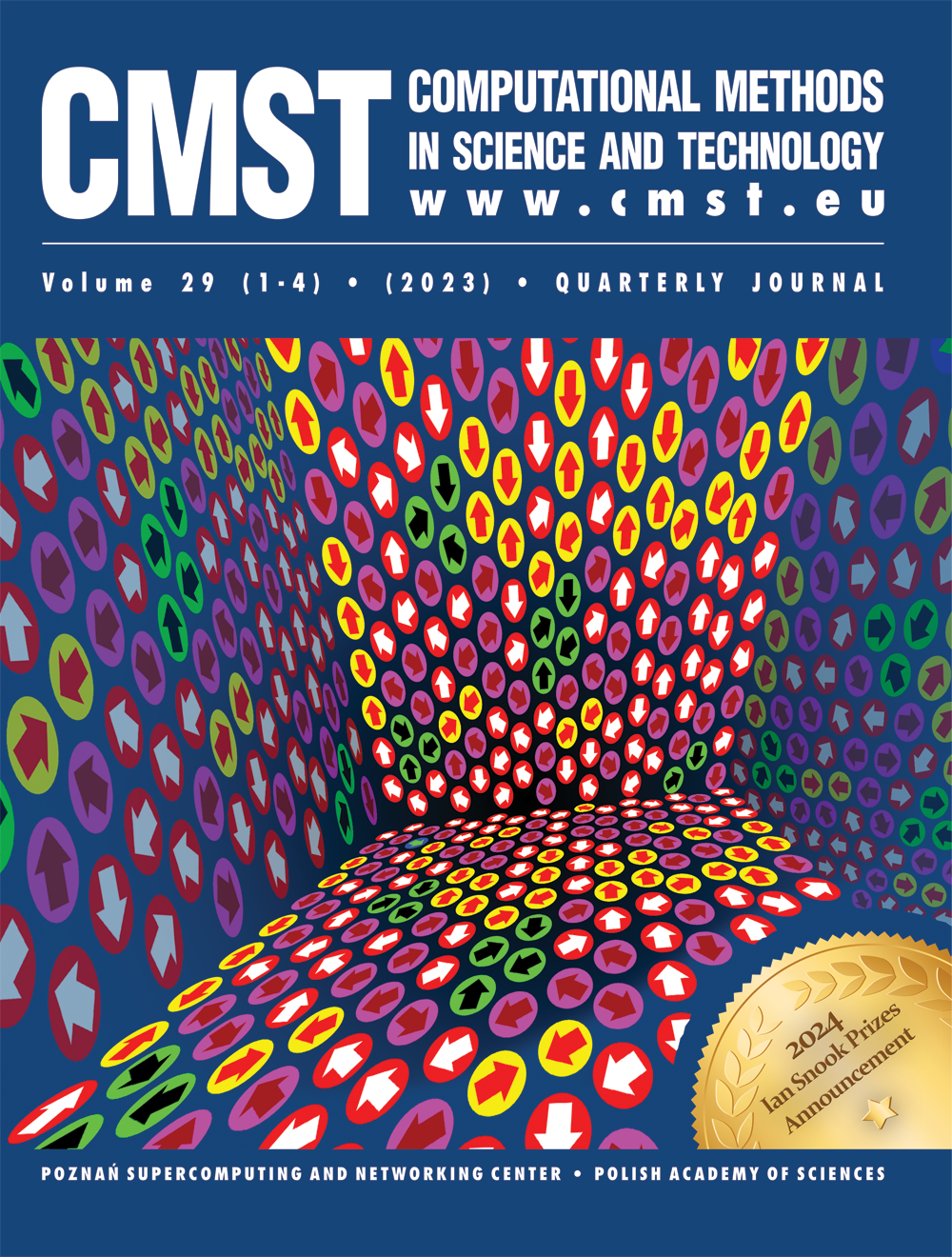THE STRUCTURE OF THE FIRST CO-ORDINATION SHELL OF Pb ATOMS IN LEAD-SILICATE GLASSES: A MOLECULAR DYNAMICS STUDY
Rybicka Anna, Rybicki Jarosław, Witkowska Agnieszka, Feliziani Sandro, Mancini Giorgio
Department of Solid State Physics, Faculty of Technical Physics and Applied Mathematics,
Technical University of Gdańsk, Narutowicza 11/12, 80-952 Gdańsk, Poland
INFM UdR Camerino, Department of Mathematics and Physics,
University of Camerino, Madonna delle Carceri, Camerino (MC), Italy
DOI: 10.12921/cmst.1999.05.01.67-74
OAI: oai:lib.psnc.pl:501
Abstract:
The structure of lead-silicate glasses, although being investigated for over sixty years, remains still controversial. One of the open questions is the structure of the lead subsystem: what are the basic structural units like, and how are they interconnected. In the literature the appearance of [PbO4]n, or [PbO3]n chains is reported even in the glasses of the same stoichiometry. In order to elucidate the problem of contradicting experimental findings, extensive molecular dynamics (MD) simulations in the isobaric-isoenthalpic (NpH) ensemble of the structure of lead-silicate glasses have been performed in the whole range of glassformation. The atoms were assumed to interact by a two-body Born-Mayer-Huggins interaction potential with full ionic charges. The potential parametrization was taken from Damodaran et al. [Phys. Chem. Glasses, 31, 212 (1990)1. The simulation box contained about 3000 atoms. For each composition an equilibrated melt at 10000 K was prepared, and then slowly (6 10 13 K/s) cooled down to 300 K, passing several 0.1 ≤ X ≤ 0.33, about 1/3 of all Pb atoms is either placed in the front of the faces of the SiO4 tetrahedra, forming Pb03 pyramids with the Pb atom in the vertices or in the middle of an almost flat triangle formed from for oxygens of three different SiO4 tetrahedra. Another 1/3 of all Pb atoms can be qualified as vertices of rather distorted square pyramids. The remaining of lead atoms have neighbourhoods difficult to classify. For x 0.67 only a few Pb atoms were identified as remaining 1/3 in the front of a face of a SiO4 tetrahedron Most of the Pb atoms are placed in the vertices of edge sharing square PbO4 pyramids. Our MD results are compared with available experimental data.
References:
[1] C. C. Wang, Phys. Rev., B2, 2045 (1970).
[2] J. L. Wiza, Nucl. Instrum. Meth., 62, 587 (1979).
[3] K. Trzebiatowski, L. Murawski, B. Koscielska, M. Chybicki, O. Gzowski, I. Davoli, Proc. of the
Conf. on Fundamentals of Glass Science and Technology, June 9-12 1997, Vaxjo, Sweden
[4] C. A. Warrel, T. Henshall, J. Non-Cryst. Solids, 29, 283 (1978).
[5] H. Verweij, W. L. Konijnendijk, J. Am. Ceram. Soc., 11-12, 517 (1976).
[6] A. M. Zahra, C. Y. Zahra, J. Non-Cryst.Solids, 155, 45 (1993).
[7] F. Fayon, C. Bessada, D. Massiot, I. Farnan, J. P. Coutures, J. Non-Cryst. Solids, 232-234, 403
(1998).
[8] F. Fayon, C. Landron, K. Sakurai, C. Bessada, D. Massiot, J. Non-Cryst. Solids, 243, 39 (1999).
[9] P. W. Wang, L. Zhang , J. Non-Cryst. Solids, 194, 129 (1996).
[10] H. Morikawa, Y. Takagi, H. Ohno, J. Non-Cryst. Solids, 53, 173 (1982).
[11] M. Imaoka, H. Hasegawa, I. Yasui, J. Non-Cryst. Solids, 85, 393 (1986).
[12] K. Yamada, A. Matsumoto, N. Niimura, T. Fukunaga, N. Hayashi, N. Watanabe, J. Phys. Soc. Jap., 55, 831 (1986).
[13] A. Witkowska, J. Rybicki, A. DiCicco, M. Minicucci, Proc. of the 5-th International Conference on Intermolecular Interactions in Matter, Lublin, 1-4 September 1999, p. 42 (1999).
[14] M. P. Allen, D. J. Tildesley, Computer Simulation of Liquids, Clarendon Press, Oxford 1987.
[15] R. W. Hockney, J. W. Easrwood, Computer Simulation using Particles, McGraw-Hill, 1987.
[16] D. C. Rapaport, Art of the Molecular Dynamics Simulation, University Press, Cambridge, 1996.
[17] A. Rybicka, PhD thesis, Technical University of Gdansk, 1999.
[18] W. Alda, private communication, 1996.
[19] H. C. Andersen, J. Chem. Phys., 72, 2384 (1980).
[20] K. V. Damodaran, B. G. Rao, K. J. Rao, Phys. Chem. Glasses, 31, 212 (1990).
[21] G. Mancini, TASK Quarterly, 1, 89 (1997).
[22] R. Balducci, R. S. Pearlman, J. Chem. Inf. Comput. Sci., 34, 822 (1994).
[23] A. Filipponi, A. Di Cicco, Phys. Rev., B 51, 12322 (1995).
[24] R. W. G. Wyckoff, Crystal Structures, Wiley-Interscience Publications, NY, 1964.
[25] M. Mydlar, N. Kreidl, J. Hendren, G. Clayton, Phys. Chem. Glass., 11, 196 (1970).
[26] B. M. J Smets, T. P. A. Lommen, J. Non-Cryst. Solids, 48, 423 (1982).
[27] M. L. Boucher, D. R. Peacor, Z. Kristallogr., 126, 98 (1968).
[28] C. Dayanand, G. Bhikshamaiah, M. Salagram, Materials Lett., 23, 309 (1995).
The structure of lead-silicate glasses, although being investigated for over sixty years, remains still controversial. One of the open questions is the structure of the lead subsystem: what are the basic structural units like, and how are they interconnected. In the literature the appearance of [PbO4]n, or [PbO3]n chains is reported even in the glasses of the same stoichiometry. In order to elucidate the problem of contradicting experimental findings, extensive molecular dynamics (MD) simulations in the isobaric-isoenthalpic (NpH) ensemble of the structure of lead-silicate glasses have been performed in the whole range of glassformation. The atoms were assumed to interact by a two-body Born-Mayer-Huggins interaction potential with full ionic charges. The potential parametrization was taken from Damodaran et al. [Phys. Chem. Glasses, 31, 212 (1990)1. The simulation box contained about 3000 atoms. For each composition an equilibrated melt at 10000 K was prepared, and then slowly (6 10 13 K/s) cooled down to 300 K, passing several 0.1 ≤ X ≤ 0.33, about 1/3 of all Pb atoms is either placed in the front of the faces of the SiO4 tetrahedra, forming Pb03 pyramids with the Pb atom in the vertices or in the middle of an almost flat triangle formed from for oxygens of three different SiO4 tetrahedra. Another 1/3 of all Pb atoms can be qualified as vertices of rather distorted square pyramids. The remaining of lead atoms have neighbourhoods difficult to classify. For x 0.67 only a few Pb atoms were identified as remaining 1/3 in the front of a face of a SiO4 tetrahedron Most of the Pb atoms are placed in the vertices of edge sharing square PbO4 pyramids. Our MD results are compared with available experimental data.
[1] C. C. Wang, Phys. Rev., B2, 2045 (1970).
[2] J. L. Wiza, Nucl. Instrum. Meth., 62, 587 (1979).
[3] K. Trzebiatowski, L. Murawski, B. Koscielska, M. Chybicki, O. Gzowski, I. Davoli, Proc. of the
Conf. on Fundamentals of Glass Science and Technology, June 9-12 1997, Vaxjo, Sweden
[4] C. A. Warrel, T. Henshall, J. Non-Cryst. Solids, 29, 283 (1978).
[5] H. Verweij, W. L. Konijnendijk, J. Am. Ceram. Soc., 11-12, 517 (1976).
[6] A. M. Zahra, C. Y. Zahra, J. Non-Cryst.Solids, 155, 45 (1993).
[7] F. Fayon, C. Bessada, D. Massiot, I. Farnan, J. P. Coutures, J. Non-Cryst. Solids, 232-234, 403
(1998).
[8] F. Fayon, C. Landron, K. Sakurai, C. Bessada, D. Massiot, J. Non-Cryst. Solids, 243, 39 (1999).
[9] P. W. Wang, L. Zhang , J. Non-Cryst. Solids, 194, 129 (1996).
[10] H. Morikawa, Y. Takagi, H. Ohno, J. Non-Cryst. Solids, 53, 173 (1982).
[11] M. Imaoka, H. Hasegawa, I. Yasui, J. Non-Cryst. Solids, 85, 393 (1986).
[12] K. Yamada, A. Matsumoto, N. Niimura, T. Fukunaga, N. Hayashi, N. Watanabe, J. Phys. Soc. Jap., 55, 831 (1986).
[13] A. Witkowska, J. Rybicki, A. DiCicco, M. Minicucci, Proc. of the 5-th International Conference on Intermolecular Interactions in Matter, Lublin, 1-4 September 1999, p. 42 (1999).
[14] M. P. Allen, D. J. Tildesley, Computer Simulation of Liquids, Clarendon Press, Oxford 1987.
[15] R. W. Hockney, J. W. Easrwood, Computer Simulation using Particles, McGraw-Hill, 1987.
[16] D. C. Rapaport, Art of the Molecular Dynamics Simulation, University Press, Cambridge, 1996.
[17] A. Rybicka, PhD thesis, Technical University of Gdansk, 1999.
[18] W. Alda, private communication, 1996.
[19] H. C. Andersen, J. Chem. Phys., 72, 2384 (1980).
[20] K. V. Damodaran, B. G. Rao, K. J. Rao, Phys. Chem. Glasses, 31, 212 (1990).
[21] G. Mancini, TASK Quarterly, 1, 89 (1997).
[22] R. Balducci, R. S. Pearlman, J. Chem. Inf. Comput. Sci., 34, 822 (1994).
[23] A. Filipponi, A. Di Cicco, Phys. Rev., B 51, 12322 (1995).
[24] R. W. G. Wyckoff, Crystal Structures, Wiley-Interscience Publications, NY, 1964.
[25] M. Mydlar, N. Kreidl, J. Hendren, G. Clayton, Phys. Chem. Glass., 11, 196 (1970).
[26] B. M. J Smets, T. P. A. Lommen, J. Non-Cryst. Solids, 48, 423 (1982).
[27] M. L. Boucher, D. R. Peacor, Z. Kristallogr., 126, 98 (1968).
[28] C. Dayanand, G. Bhikshamaiah, M. Salagram, Materials Lett., 23, 309 (1995).



